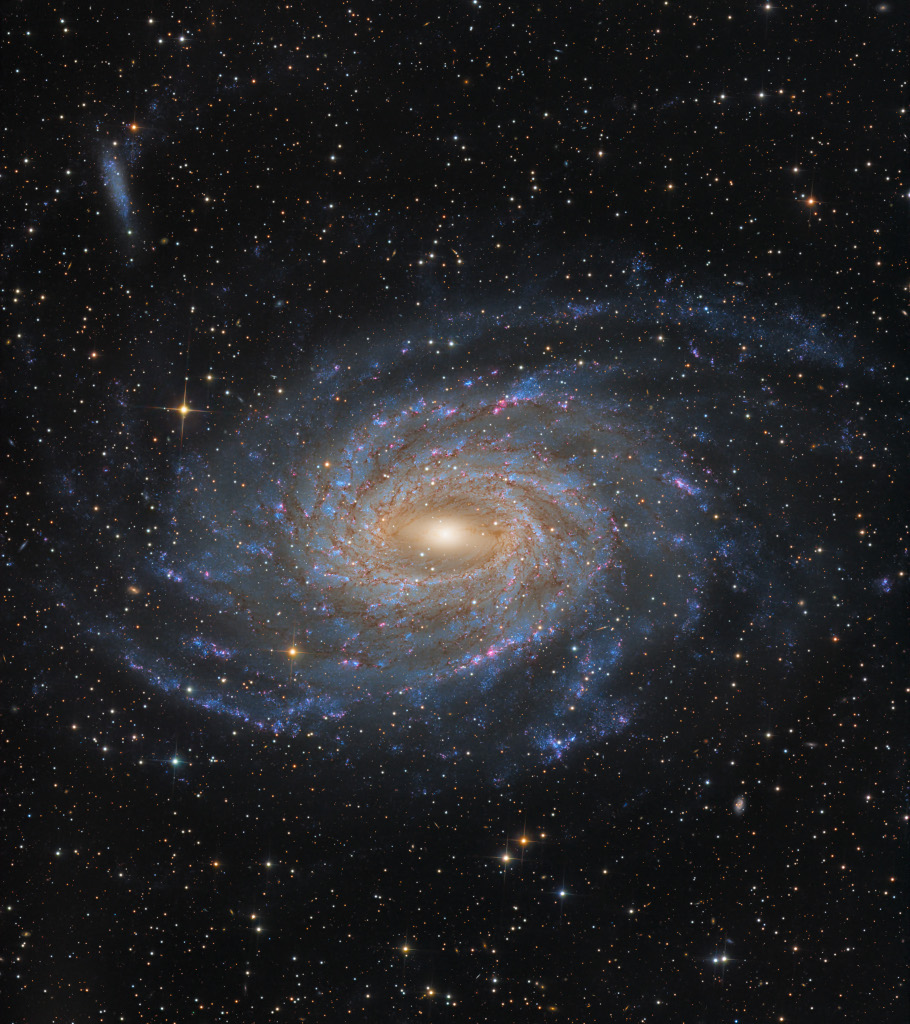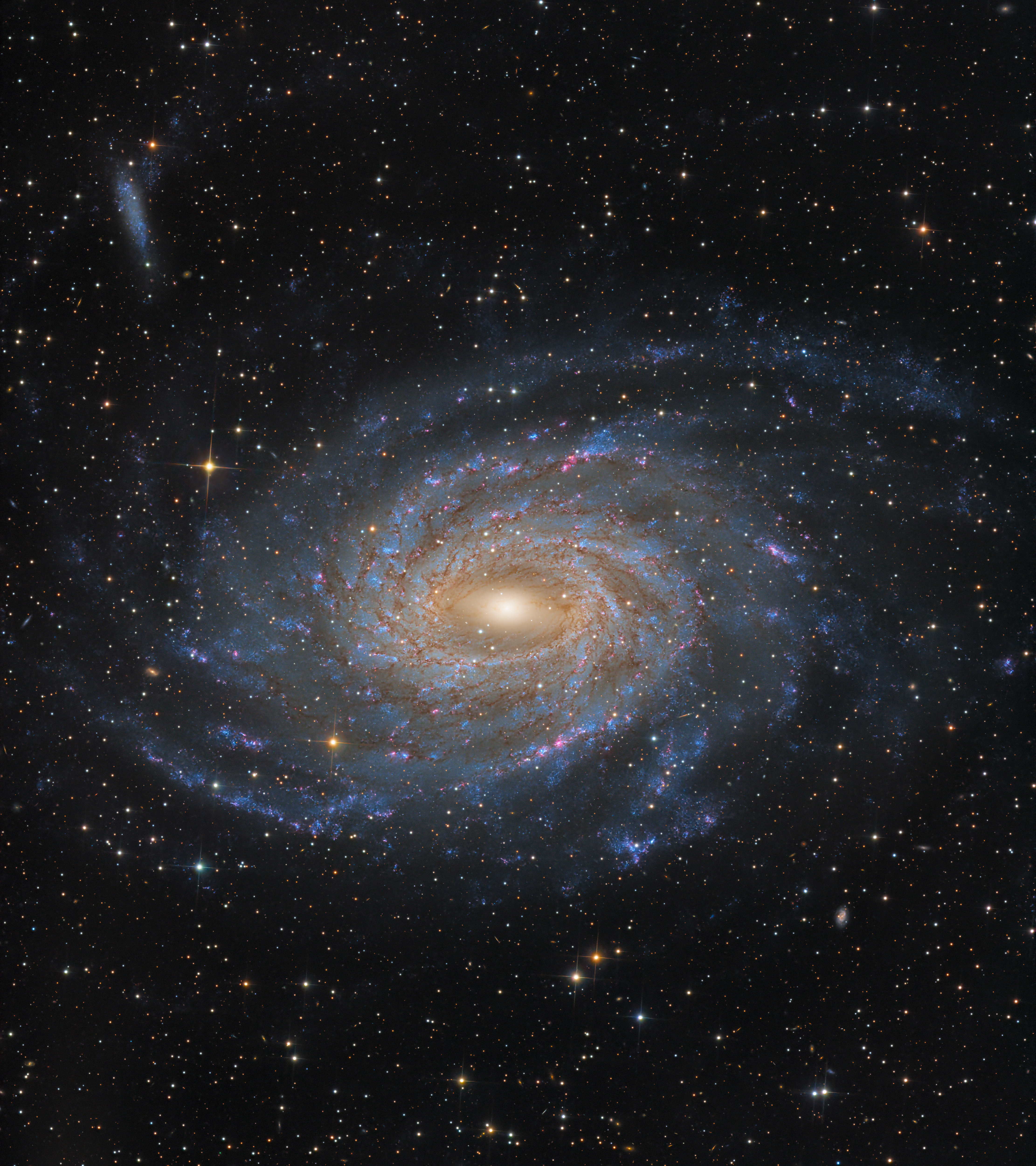Nice APOD!
But as a Color Commentator, I scratch my head over this image - and over NGC 6744 in general. I mean, doesn't it look blue?
███ But according to the standard method of determining the overall color of a galaxy (or, for that matter, a star), the B-V index, NGC 6744 is "on the yellow side" of galaxies!
███
Let me explain. The B-V index measures the flux of B (blue) light versus the flux of V (yellow-green) light. The smaller the value, the bluer is the star or the galaxy, and the larger the value, the yellower (or, in the case of some stars, the redder) the object is.
Galaxies have pale colors, because they are made up of large numbers of stars of different colors. Elliptical galaxies with no star formation are typically made up of old stars only. Most stars in an old population of stars will be yellow or red, but some will still be "white" like the Sun. (Yes, the Sun is white, or possibly yellow-white.) And an extremely small fraction of the stars will actually be blue even in an old population, because they will be blue straggler stars or extremely old and metal-poor blue horzontal branch stars.
However, the typical color of elliptical or lenticular galaxies, whose populations are typically "all old", is around 0.90 to 0.99. We may "translate" these B-V numbers to a color between the hue of the bright star Capella, and the hue of the bright star Pollux, though it is closer to Pollux.
A yellow elliptical galaxy full of old stars is giant elliptical galaxy M87:
As for "The Eyes", this is a better portrait of them. You can see that the thin distorted arms of NGC 4438 are a very pale shade of blue:
Spiral starforming galaxies contain different populations of stars of different colors. Young populations, typically found in spiral arms, get their color from very bright blue stars, although there are almost always also a few bright evolved red stars among them. Old populations are found in the spiral galaxies' centers, and they are yellow, just like the yellow populations of elliptical galaxies.
Photographing spiral galaxies containing both young and old populations is difficult when it comes to showing their "true colors". Here are two pictures of the well-known Whirlpool Galaxy, M51:
Anyway, back to NGC 6744. Let's look at the APOD again, and compare it with an ultraviolet picture from GALEX, which highlights the hot blue stars of the galaxy:
As you can see from the GALEX image, NGC 6744 is absolutely crammed full of ultraviolet light. This suggests that NGC 6744 is a quite blue galaxy. And yet, its B-V is as high as 0.86!!! That's higher than the B-V of NGC 4438 with its gossamer thin blue arms! That's crazy!!
I think there are two explanations for the crazily red B-V index for blue-looking NGC 6744. First, the B-V value for NGC 6744 is not its "total" but its "effective" B-V, and those values may well be different, for all I know. The second explanation is that its yellow center must be bright, and its blue arms and armlets must be dim. I think that is the most reasonable explanation. The ultraviolet stars are most certainly there in NGC 6744, scattered all over the place, but they are nowhere near as numerous, and their combined light is nowhere near as bright, as the APOD (and GALEX) lead us to believe.
So why does NGC 6744 look as blue as it does in the APOD? I'd say, filters and processing. Because it is so, so, so hard to produce a "true" color image of a galaxy!!
Finally, how bright and large is NGC 6744? Who knows. This is what Wikipedia said about the distance to NGC 6744:
Wikipedia wrote:
NGC 6744 (also known as Caldwell 101 or the Pavo Galaxy) is an intermediate spiral galaxy in the constellation Pavo (Peacock). Its velocity with respect to the cosmic microwave background is 802 ± 3 km/s, which corresponds to a Hubble distance of
38.6 ± 2.7 Mly (11.82 ± 0.83 Mpc). However, 21 non redshift measurements give a distance of
23.63 ± 1.68 Mly (7.244 ± 0.514 Mpc).
So the distance to NGC 6744 is either ~39 million light-years, or ~24 million light-years. If it is 39 million light-years away, then NGC 6744 is sure big and impressive! But if it is "only" 24 million light-years away, then it becomes much less remarkable.
Take your pick. They say that NGC 6744 is a Milky Way twin. I have absolutely nothing to say about that!!
Ann
 Spiral Galaxy NGC 6744
Spiral Galaxy NGC 6744







